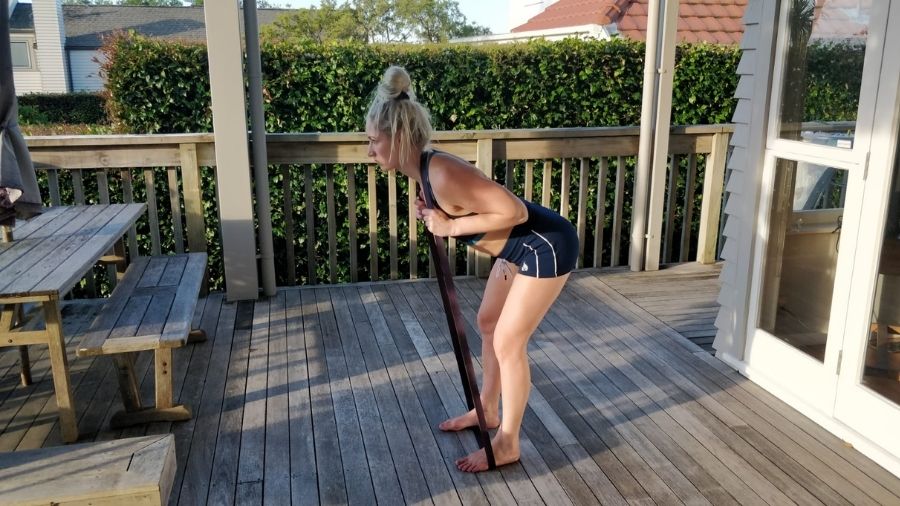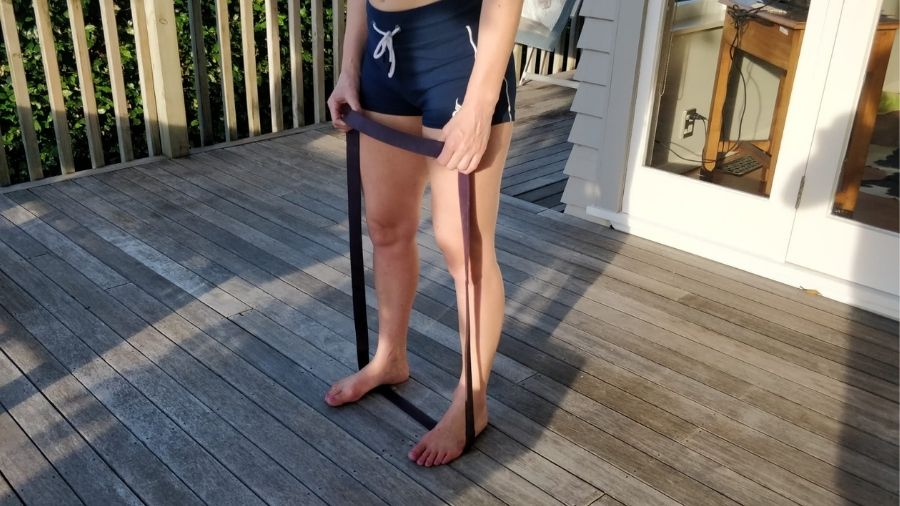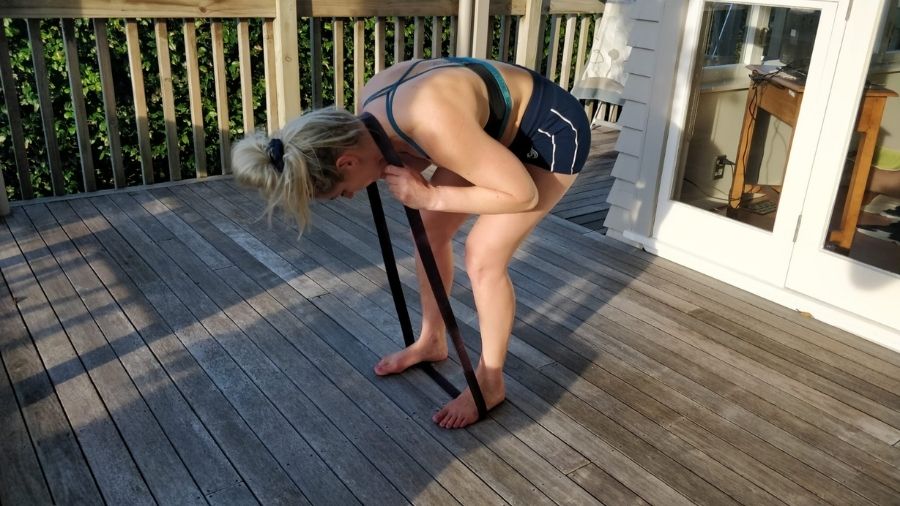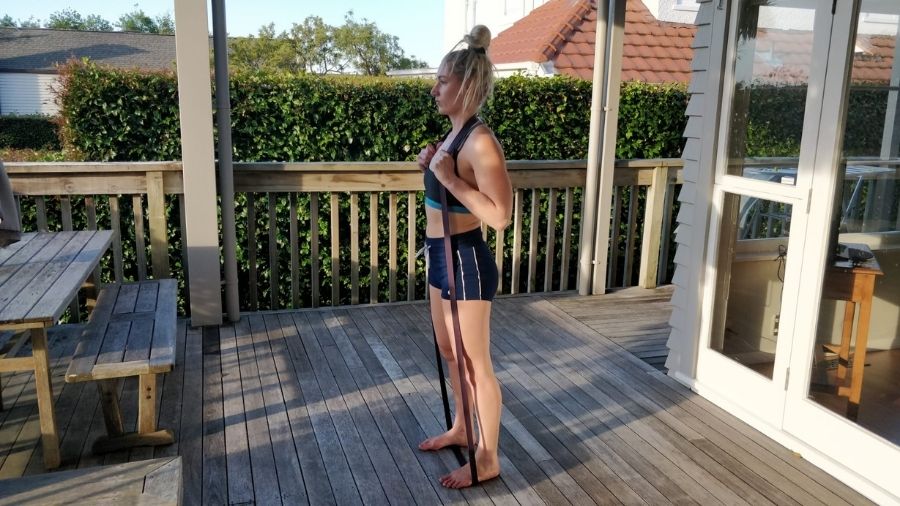If you’re stuck at home or travel often, you may be looking for a new exercise to spice up your workouts. So many at-home exercises focus on the muscles at the front of your body and neglect the muscles at the back. This is why you must include the banded good morning into your training routine.
The banded good morning is a hip hinge exercise similar to the Romanian deadlift except you are standing on a band with it looped around your neck to create external load.
So why should you use the banded good morning and what muscles does the exercise work?
Table of Contents
What Muscles Does The Banded Good Morning Work?
Good mornings are a posterior development exercise meaning it works the muscles at the back of your body. These mainly are the erector spinae, glutes, and hamstrings. In fact, the good morning activates the muscles of the hamstrings to a greater extent than the glute-ham raise and lying leg curl [1].
Further, due to the movement similarities to the Romanian deadlift, the banded good morning shows similar muscle activation of the erector spinae [1]. It's important to note however that muscle activation during the good morning is a function of load and therefore, using bands may not work the erector spinae, glutes, and hamstring muscles maximally [2].
Benefits Of The Banded Good Morning

The banded good morning has many benefits regardless of whether you are looking to add mass, increase strength, or just get your sweat on.
Reduced Load At The Hardest Position
The hardest position during a good morning is when you're bent over with your back close to being parallel to the floor. This is where your hamstrings and glutes are maximally stretched and your lower back is working its hardest to stabilize your upper body.
When using a barbell, the load placed on these muscles increases as you push your hips back and bend over. But with the band, this is reversed. Because band tension decreases as you lower yourself, the stress placed on your muscles is also reduced. Therefore, the exercise gets harder, not easier as you raise yourself back to the starting position.
If you have any lower back problems, this exercise is one you should be using to train your glutes, hamstrings, and lower back.
Light Enough To Use As A Warm-Up
Because the banded good morning uses resistance bands for tension, they generally don't provide much resistance making them the perfect warm-up exercise to use before a lower-body gym session. Performing 10-20 reps with a light band will light your hamstrings and glutes up getting you ready to attack your first exercise.
Can Be Done For High Reps
The barbell good morning is difficult to perform for high reps as you don't want fatigue as you lower yourself with the barbell. Fatigue leads to sloppy reps which can lead to a lower back injury. Since bands decrease the tension as you lower yourself, you’re able to perform very high reps which is great for stimulating high levels of metabolic stress and therefore, muscle growth.
Minimal Equipment Needed
You can do banded good mornings anywhere. Stuck in a hotel for work? Just take your bands with you in your luggage and you can get a great workout by your bed. Banded good mornings also make a great addition to your at-home workouts.
Different Bands Give Different Resistance
With the popularity and low cost of resistance band training, you have many easily accessible options when it comes to band tension. If you are a novice, you can use the small to medium thick resistance bands and get a great workout.
For those who are already strong, you can work your way to the thickest resistance band to strengthen the glutes and hamstrings.
Lengthen The Hamstrings Without Static Stretching
The good morning places extra emphasis on the eccentric phase of the exercise. This eccentric is what lengthens the muscle while strengthening it. It helps to reduce the risk of injury and will improve your mobility to a greater extent than static stretching.
By strengthening the hamstrings while lengthening them, you change the angle at which they produce peak torque (force). Therefore, when placed in a lengthened position when producing force, they are less likely to be injured.
How Do You Do Good Mornings With Resistance Bands?
The banded good morning is performed with a few easy steps.
Step 1

Place your feet onto the resistance band just outside shoulder width. You should be holding the other side of the band in your hands.
Step 2

Bend down so you can loop the band around the back of your neck. Then stand up.
Step 3

Hold each side of the resistance band in your hands and start to push your hips back. Your knees should be slightly bent and not bend any further. Keep a big chest and a neutral lower back. Your weight should be toward your heels while keeping your feet flat.
Step 4

Once you feel a strong hamstring stretch and you can’t push your hips back any further, thrust your hips forward to return to the starting position.
Banded Good Mornings Alternatives
Here are some banded good morning alternatives in case you wanted to spice up your workouts or you don't have any bands available.
Romanian Deadlift
The Romanian deadlift is exactly the same as the banded good morning except you are holding the load in your hands. You can hold a barbell, dumbbells, or even a kettlebell. Using the same steps as above, push your hips back until your feel a wicked hamstring stretch then thrust your hips forward to return to the upright position.
Good Morning
The obvious alternative to the banded good morning is the good morning with the barbell on your back. You will need to keep a tight upper back with your arms pulling down on the barbell so it stays on your back and doesn’t roll up to your neck when performing the movement.
Single-Leg Romanian Deadlift
The single-leg Romanian deadlift is a great alternative as it doesn't require much external load to hit the hamstrings and glutes hard. You want to be able to use your hips as a fulcrum like the middle of a see-saw and keep a straight line from your head to your free leg heel.
Hold a dumbbell or kettlebell in the hand that is opposite to the leg that is planted on the floor. You don’t need to lower the weight down to the floor as this will often be too far. As soon as you feel a strong hamstring stretch, return to the starting position.
Band or Cable Pull Through
I'm not a huge fan of the pull-through but it can be used as an alternative to the banded good morning. Simply tie a band by the floor against an immovable object or use a cable stack if you are in a gym.
Face away from the band and reach through your legs to hold it. Create a big chest and neutral lower back with your knees slightly bent and your hips push back. Without using your shoulders or arms to pull the band, thrust your hips forward so you are standing upright. Reverse the movement to get the stretch through your hamstrings.
Frequently Asked Questions
Are Banded Good Mornings Good?
Banded good mornings are a good exercise for developing the muscles of the lower back, glutes, and hamstrings under lighter loads with minimal equipment.
Do Bodyweight Good Mornings Do Anything?
Bodyweight good mornings don’t do much but can be used as part of a dynamic warm-up to get your hips and hamstrings feeling warm before activity.
Are Good Mornings Better Than Deadlifts?
Good mornings are not better than deadlifts and deadlifts are not better than good mornings. It depends on your purpose for selecting each exercise. Deadlifts are better for lifting heavier loads to develop maximal strength whereas good mornings make a great accessory exercise to the deadlift that targets the hamstrings to a greater extent.
Summary
Use the banded good morning to get some extra volume without the systemic fatigue related to heavier barbell loads. Further, give it a try in your next warm-up and see how ready you feel to deadlift or squat. It's a game-changer.
References
1. McAllister, M. J., Hammond, K. G., Schilling, B. K., Ferreria, L. C., Reed, J. P., & Weiss, L. W. (2014). Muscle activation during various hamstring exercises. The Journal of Strength & Conditioning Research, 28(6), 1573-1580.
2. Vigotsky, A. D., Harper, E. N., Ryan, D. R., & Contreras, B. (2015). Effects of load on good morning kinematics and EMG activity. PeerJ, 3, e708.
